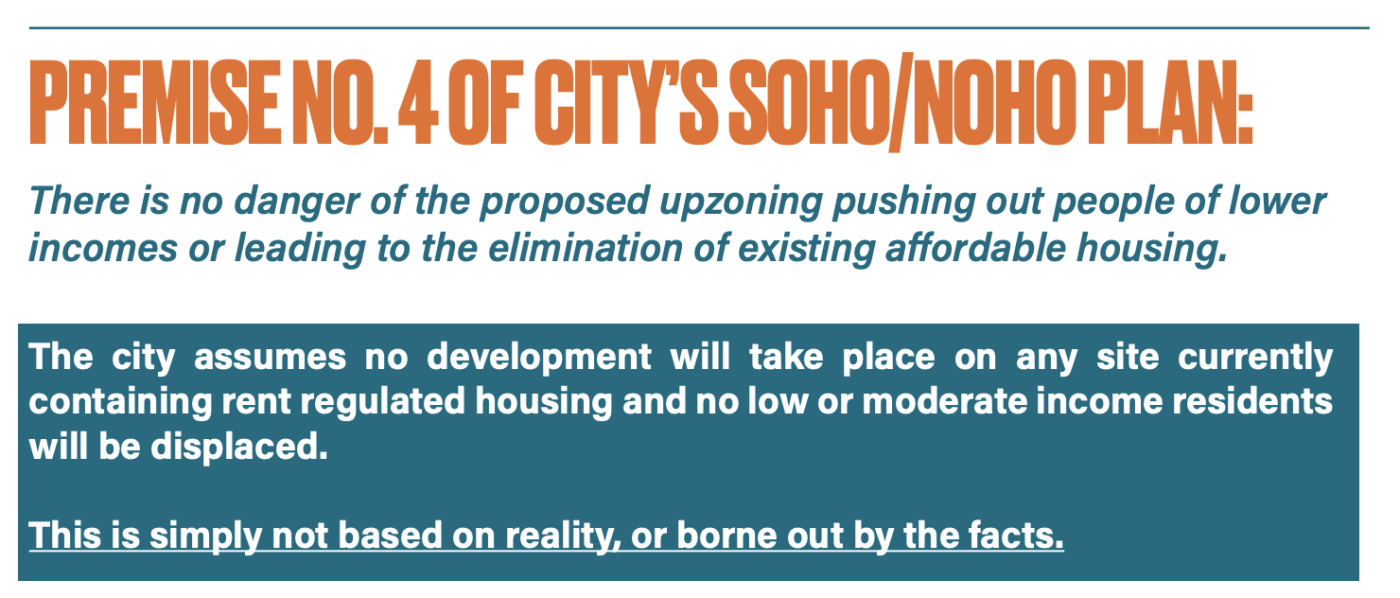City’s SoHo/NoHo Rezoning Plan Includes Part of Chinatown, and Hundreds of Rent Regulated Units Could Be Lost
The newly-released study by Village Preservation shows that the City’s SoHo/NoHo Rezoning Plan, which includes part of Chinatown, will make the area richer, whiter, and more expensive to live in than now, increase demolition pressures on existing rent regulated units, and potentially destroy more affordable housing than it creates.

Town Hall and Teach In
Tonight Village Preservation is hosting a Town Hall and Teach In on the study and its findings — RSVP HERE. It is co-hosted by the Broadway Residents Coalition, NoHo Neighborhood Alliance, LES CommUnity Concerns, Lower Manhattan Loft Tenants, 318 Restaurant Workers Union and…

In the fall of 2020, the de Blasio administration announced its plans to rezone the neighborhoods of SoHo and NoHo, saying it would “advance the City’s goals of fair housing and equitable growth” and “create a more inclusive…SoHo and NoHo” as part of “a more equitable and integrated city.”
Under the City plan, new development may in many cases result in the displacement of lower income residents and the destruction of affordable housing. In a “best case” scenario, existing residential buildings with affordable, rent-regulated housing and lower-income residents will be destroyed for new residential construction that is 70-80% super-luxury/20-30% “affordable.”

But in many cases, such existing housing will be destroyed under the city plan for commercial development, with no affordable housing whatsoever.
We have identified 635 rent regulated units in 105 buildings within the rezoning area.

Many of these units and buildings will be made vulnerable to demolition as a result of the proposed upzoning, though the City’s draft EIS categorically excludes all of these as potential development sites, and discounts the possibility of losing these units as a result of the upzoning.
Nearly all are located in buildings which are overbuilt or nearly overbuilt under existing zoning, and thus currently unlikely to be demolished. All of those would be underbuilt, or significantly more underbuilt, under the proposed rezoning, thus creating tremendous new incentive for demolition.

They are disproportionately located in the southeast “Housing Opportunity Zone,” one of three zones with the largest proposed upzoning and therefore the largest incentive for demolition. This area also has the highest concentration of Asian-Americans (a plurality) and lower-income residents in the rezoning area.
EXAMPLE OF SOME OF THE 105 BUILDINGS WITH RENT REGULATED UNITS IN PROPOSED REZONING AREA

— Allowable size of new development under existing zoning (l.) / proposed zoning under city plan (r.)

The City claims that these units should not be considered vulnerable to demolition, because, among other reasons, NYS laws make demolition of rent regulated units difficult.
However, this is a false assumption because: a) With the high economic incentives for development in lower Manhattan, we commonly see demolitions of buildings with rent regulated units when there are even moderate differentials between built FAR and zoning.
EXAMPLES OF RECENT NEARBY DEMOLITIONS OF BUILDINGS
WITH RENT REGULATED UNITS RESULTING FROM MODERATE TO-SIGNIFICANT DIFFERENTIALS IN ALLOWABLE FAR


The bottom line is this: Under the proposed upzoning, buildings with rent-regulated units are placed in greatly increased danger of being demolished, thus likely leading to a LOSS of affordable housing that is not accounted for in the City’s proposal.

The city’s SoHo/NoHo upzoning plan will make these neighborhoods richer and whiter, make housing prices overall much more expensive than they are now, likely destroy a considerable amount of affordable housing, and create about 80% less affordable housing than projected. It will allow grossly out of scale development and a flood of super luxury condos at prices averaging over $6 million for households with incomes averaging over $1 million, as well as large new office buildings and big box chain stores. The city is ignoring the clear evidence of the impact which this plan would have, not just on SoHo and NoHo but adjacent neighborhoods like Chinatown and the Lower East Side, continuing a pattern of wildly inaccurate projections and prognostications about what their rezonings would do.
There are ways to make SoHo and NoHo more affordable and equitable, as well as to update nearly fifty year old zoning which in some cases may conflict with present-day realities. The city’s plan is not the way to do so. It will exacerbate problems of affordability and inequality in these neighborhoods, and in adjacent neighborhoods which will also be impacted. And it will destroy the qualities of the built environment, the artistic heritage, and the unique character of these neighborhoods which have made SoHo and NoHo successful and sought-after.

The Community Alternative Rezoning Plan, developed by a group of civic and community organizations, lays out a plan that would not destroy any affordable housing or push out any existing residents, but would create as much if not more affordable housing than the city’s plan, especially if combined with direct subsidies for the construction of new affordable housing in the neighborhood.
Help us fight to promote and protect equitable, diverse, affordable neighborhoods that respect and preserve history and neighborhood character:
